Are you an apartment dweller wondering if having a dog is feasible despite the space constraints and noise concerns?
Welcoming a dog into your apartment or condo can make your living space feel cozier and bring joy into your daily routine.
Certain dog breeds adapt better to smaller living spaces due to their size, energy levels, and temperament. This guide will introduce you to the top dog breeds perfectly suited for apartment living, focusing on those with minimal barking tendencies and low-maintenance needs.
Key Takeaways
- Top dog breeds for apartment living with minimal barking
- Factors to consider when choosing a breed for small spaces
- Low-maintenance dog breeds perfect for busy owners
- Tips for keeping your dog and neighbors happy in close quarters
- Common challenges of apartment living with dogs and how to overcome them
Finding the Perfect Canine Companion for Small Spaces
Before you start looking for a new furry friend, understanding your apartment’s rules and regulations regarding pets is essential. Many apartments have specific guidelines concerning dog weight, breed, or temperament restrictions that can significantly impact your decision.
Understanding Apartment Pet Policies
Selecting the right dog for apartment living requires careful consideration of multiple factors beyond just breed characteristics. Your building’s specific pet policies and restrictions play a crucial role in this decision.
- Many apartment complexes have weight limits, breed restrictions, or pet deposits that will impact your options before you even begin your search for the perfect companion.
- The limited space of apartment living means you’ll need to find a dog whose size, energy level, and exercise requirements align with what you can reasonably provide in your living situation.
- Your daily schedule and lifestyle are crucial considerations—some breeds can handle being alone during work hours better than others, which is essential for apartment dwellers with full-time jobs.
This section will help you understand the fundamental considerations for apartment dog ownership, setting realistic expectations about the commitment required to keep both your dog happy and your neighbors undisturbed.
By balancing your desire for a canine companion with the practical realities of apartment living, you’ll be able to make an informed decision that works for everyone involved. Whether you’re looking for best apartment dogs or simply trying to understand the needs of dogs in apartments, this guide is here to help you navigate the process.
When considering pets, especially dogs, for your apartment, it’s vital to think about the overall lifestyle you’ll be able to provide. This includes understanding the exercise needs, grooming requirements, and socialization necessary for your dog to thrive in a smaller living space.
What Makes the Best Apartment Dogs Stand Out?
The ideal apartment dog is one that thrives in a smaller space with minimal disruption. Several factors contribute to a breed’s suitability for apartment living, including size, noise level, and energy requirements.
Size Considerations: Small to Medium Dogs vs. Calm Large Breeds
While it’s often assumed that only small dogs are suitable for apartments, calm large breeds can also thrive in these environments. Small to medium-sized dogs are generally a safe choice due to their compact size and lower exercise needs. However, some larger breeds, such as the Great Dane or Mastiff, can be surprisingly well-suited to apartment living if they are calm and have low energy levels.
- Small breeds like the French Bulldog and Pug are popular choices due to their compact size.
- Medium-sized dogs, such as the Basset Hound, can also adapt well if they have a calm temperament.
- Large breeds with low energy levels, like the Greyhound, can be a good fit for apartment living despite their size.
Noise Level: Low-Barking Breeds for Happy Neighbors
A dog’s noise level is a critical consideration for apartment dwellers. Breeds that bark frequently can be a source of tension with neighbors. Low-barking breeds are generally more suitable for apartment living.
Some breeds are naturally quieter than others. For example, the Boston Terrier is known for being relatively quiet, while the Pug is generally not a excessive barker.
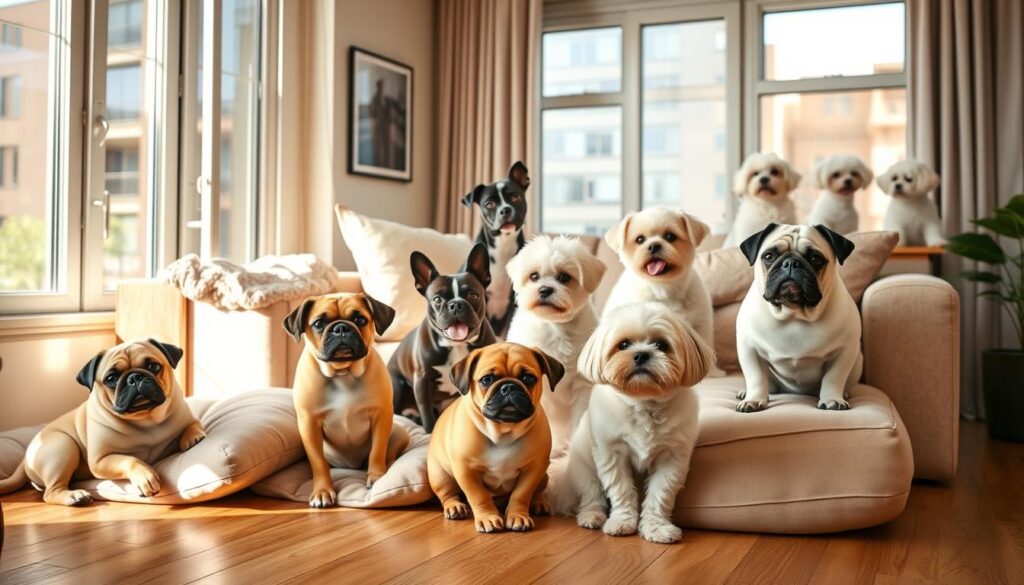
Energy Requirements: Exercise Needs Without a Yard
Living in an apartment without a yard means you’ll need to be strategic about meeting your dog’s exercise needs through other means. Different breeds have varying energy levels and exercise requirements that must be considered when choosing an apartment dog.
Creative solutions for exercising high-energy dogs in urban environments include dog parks, indoor games, and structured walks. Understanding a breed’s natural energy level before adoption will help you realistically assess whether you can meet their exercise needs within your apartment lifestyle.
Key Factors to Consider Before Choosing an Apartment Dog
Choosing the right dog for apartment living involves several key considerations to ensure a harmonious living environment. When deciding to bring a dog into your apartment, it’s essential to evaluate various factors that can impact both your lifestyle and that of your neighbors.
Building Restrictions and Pet Policies to Check First
Before adopting a dog, it’s crucial to review your apartment complex’s pet policy. Some buildings have specific restrictions on dog size, breed, or number of pets allowed per unit. Understanding these rules beforehand can save you from potential issues later on.
Matching Your Lifestyle and Activity Level with Your Dog
Your dog’s energy level should align with your lifestyle and activity level. If you’re away from home for extended periods or have limited mobility, a low-maintenance dog breed might be more suitable. Considering your daily routine will help you choose a dog that fits seamlessly into your life.
Grooming Needs and Shedding in Limited Living Spaces
Dogs with high grooming needs or those that shed heavily may not be ideal for apartment living due to space constraints. Breeds with low shedding or hypoallergenic qualities can be a better fit for small living spaces.
Temperament and Sociability with Neighbors and Other Pets
A dog’s temperament is crucial in apartment settings where encounters with neighbors, visitors, and other pets are frequent. A friendly and adaptable dog is more likely to get along with people and other pets
Socialization plays a key role in helping your dog become comfortable with the comings and goings in apartment buildings. By understanding the importance of a dog’s sociability and taking steps to socialize them, you can create a stress-free environment for both your dog and those around them.
1. French Bulldog: The Quiet, Low-Energy Apartment Favorite
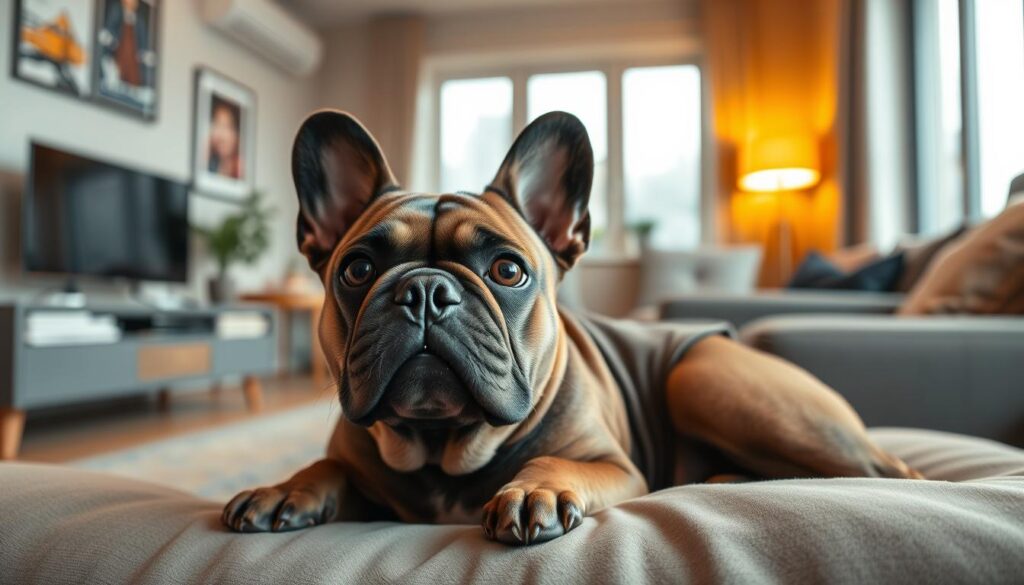
With its laid-back attitude, the French Bulldog makes an excellent companion for city living. These dogs are known for their playful, inquisitive, and affectionate nature, making them a joy to be around. French Bulldogs, or “Frenchies,” get along well with everyone, including other dogs, and they thrive on human contact.
Friendly Temperament and Minimal Barking Tendencies
French Bulldogs are renowned for their friendly temperament. They are not known to bark a lot, which makes them an ideal choice for apartment living where noise levels need to be kept to a minimum. Their affectionate nature means they love to be around people and enjoy being part of the family.
Modest Exercise Needs Perfect for City Living
One of the advantages of having a French Bulldog is their modest exercise needs. They don’t require a lot of space to run around, making them perfect for city apartments. Short walks and playtime indoors are sufficient to keep them happy and healthy. It’s also important to note that French Bulldogs can be susceptible to overheating due to their short snout, so exercise should be managed carefully.
Simple Grooming Routine for Busy Owners
The French Bulldog has a short, fine coat that requires minimal grooming. Occasional brushing is enough to keep their coat in good condition. Additionally, their facial folds need regular cleaning to prevent skin issues. This simple grooming routine makes them a great choice for busy apartment dwellers who want a low-maintenance dog.
2. Basset Hound: The Easygoing, Family-Friendly Companion
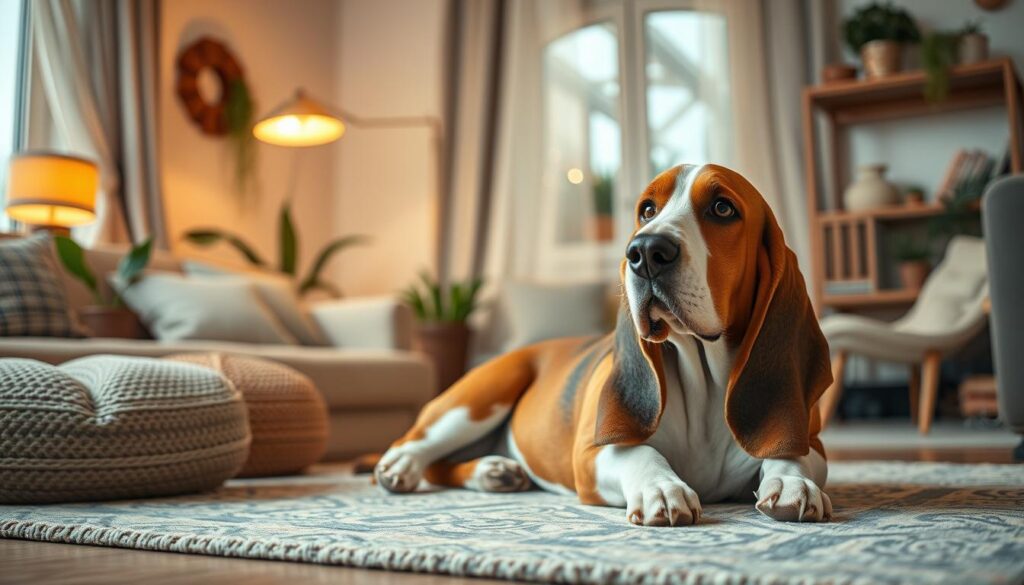
With its easygoing temperament, the Basset Hound is well-suited for apartment life. Maxing out at about 60 pounds, this breed is the perfect family pet due to its good-natured personality and adaptability.
Good-Natured Personality with Children and Strangers
Basset Hounds are great with children because they’re not easily annoyed and are very patient. They’re also not shy around new people or pets, making them highly adaptable to various social situations. Their calm demeanor makes them an excellent choice for families living in apartments.
Low Energy Requirements Despite Medium Size
Despite their medium size, Basset Hounds have low energy requirements, making them perfect for apartment living where space is limited. They don’t need a lot of exercise, but they do enjoy short walks and playtime. This breed is generally happy to lounge around the apartment, making them a great fit for less active owners.
Coat Maintenance and Occasional Barking Considerations
Basset Hounds have a short, dense coat that requires minimal grooming and maintenance. They need weekly brushing to keep their coat in good condition and to reduce shedding. While they are not excessive barkers, Basset Hounds do have a distinctive howl that owners should be prepared for. Understanding these aspects will help you decide if a Basset Hound is the right fit for your apartment living situation.
3. Boston Terrier: The Adaptable, Enthusiastic Urban Dog
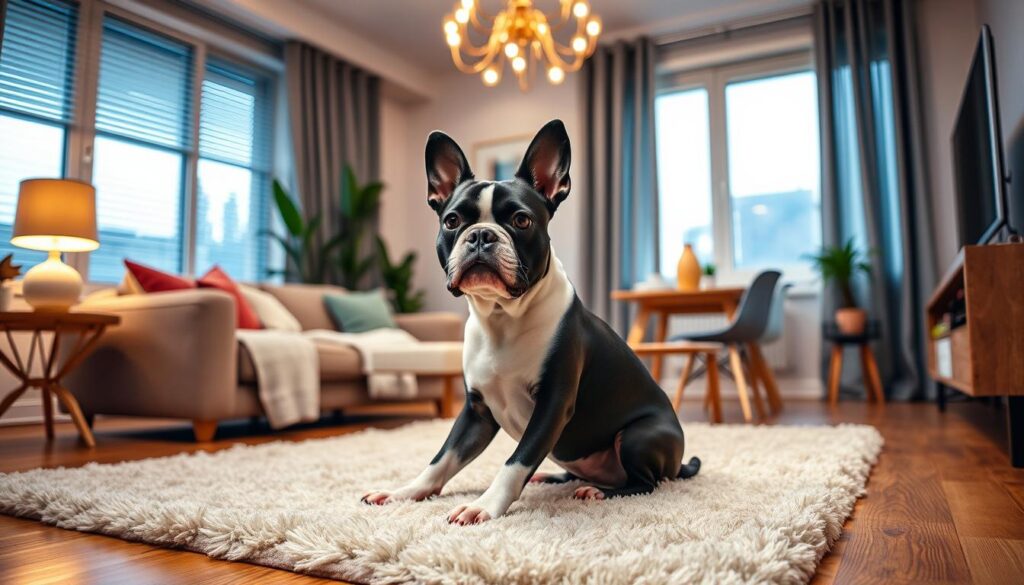
The Boston Terrier is a versatile breed that excels in apartment living due to its loving and devoted nature. This breed is perfect for fairly active apartment dwellers who can provide the necessary daily walks and playtime. Boston Terriers are known for their enthusiastic personalities and adaptability to urban environments.
Loving, Devoted Personality in a Compact Package
Boston Terriers are characterized by their loving and gentle disposition, making them excellent companions for individuals and families alike. Their small size and affectionate nature mean they thrive on human interaction and are often described as “lap dogs.” Despite their energetic bursts, they are generally happy to snuggle up and relax with their owners.
Moderate Exercise Needs Satisfied with Daily Walks
While Boston Terriers require daily exercise to maintain their physical and mental health, their needs are relatively modest. A daily walk around the block or a short play session indoors can suffice. This makes them an ideal choice for apartment living where outdoor space is limited.
Minimal Grooming Requirements for a Clean Apartment
One of the advantages of owning a Boston Terrier is their low-maintenance coat. Their short, fine coat requires only occasional brushing to keep it clean and healthy. Additionally, Boston Terriers are known for their light shedding, which contributes to easier apartment maintenance. It’s also important to clean their facial folds regularly to prevent skin issues.
4. Pug: The Charming, Low-Maintenance Lap Dog
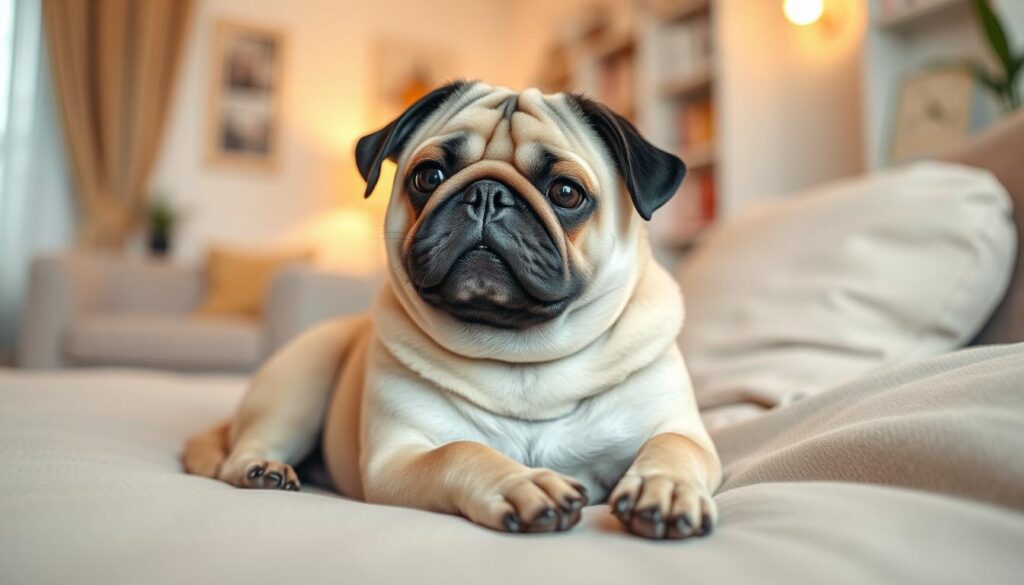
For those living in apartments, the Pug is an ideal companion, offering affection without the need for a large yard. With their laid-back attitude, quietness, and size, Pugs earn a spot on our list of the best dog breeds for apartments and condos of all sizes.
Pugs are even-tempered, affectionate, and jovial companions. They do not bark loudly, making them a great choice for apartment living where noise needs to be kept to a minimum. Their friendly nature means they quickly befriend people of all ages and get along well with other pets, especially if they’re socialized at a young age.
Even-Tempered Nature and Quiet Demeanor
Pugs are known for their calm and gentle nature. They are not high-strung or anxious, which makes them a great fit for apartment living. Their quiet demeanor means they won’t disturb neighbors, and their even-tempered personality ensures they are always a joy to be around.
Indoor Play Sessions and Short Walks Suffice
Pugs don’t require a lot of exercise, making them perfect for apartment living. Indoor play sessions and short walks are enough to meet their exercise needs. This means you can keep your Pug happy and healthy without needing a large yard.
Simple Care Needs (Despite the Snoring)
Pugs have straightforward care requirements that make them relatively low-maintenance companions for apartment dwellers. They require regular grooming, including facial fold cleaning and occasional brushing. Their brachycephalic (flat-faced) structure can lead to snoring, but with proper care, they can thrive in an apartment environment.
Understanding the Pug’s needs and being prepared for their specific requirements will help you determine if this breed is right for you. With the right care and attention, a Pug can make a wonderful and loving companion in any apartment.
5. Greyhound: The Surprisingly Lazy Sprinter
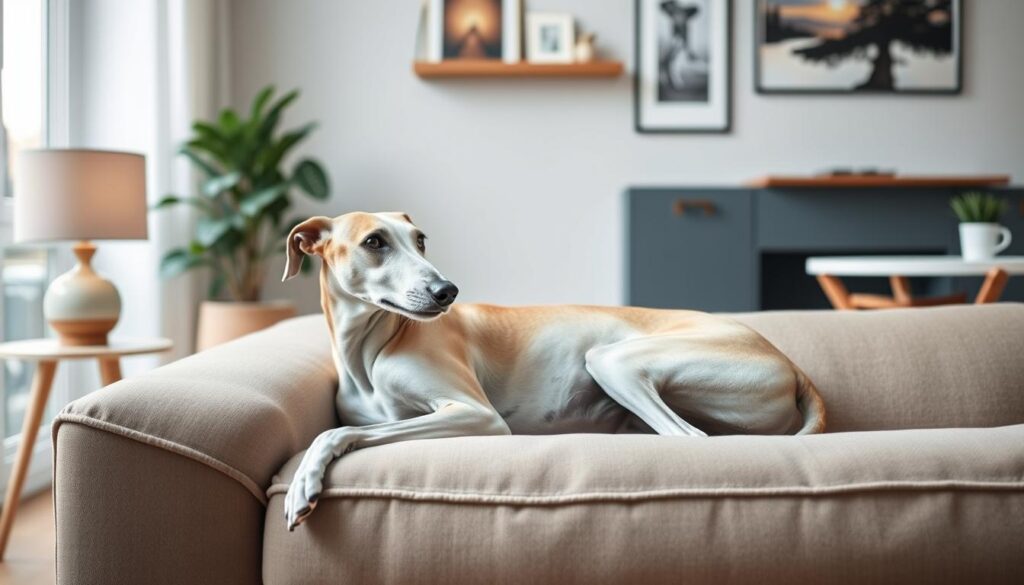
The Greyhound, a breed renowned for its speed, is an unexpected yet excellent choice for apartment dwellers. Despite their history as racing dogs, Greyhounds are known to be gentle, affectionate, and laid-back, making them a great fit for apartment living.
Gentle, Affectionate Temperament Despite Racing Background
Greyhounds are often described as noble and elegant. Their calm demeanor makes them an excellent companion for apartment residents. They are not overly demanding and are happy to adapt to a relaxed lifestyle.
Couch Potato Tendencies with Occasional Sprint Needs
Although Greyhounds are incredibly fast, they are not high-energy dogs. They require moderate exercise, such as a daily walk, and occasional opportunities to sprint in a securely fenced area. This balance makes them suitable for apartment living without needing a large yard.
Minimal Grooming for the Short, Smooth Coat
One of the advantages of having a Greyhound is their low-maintenance coat. Their short, smooth fur requires only occasional brushing, making them ideal for busy apartment dwellers. Additionally, their light shedding pattern contributes to easier apartment maintenance.
6. Dachshund: The Spirited Small Space Companion

With their lively, comical, and kind nature, Dachshunds are ideal for apartment living, providing companionship without needing a large yard. These charismatic hounds are loyal companions who want to please, making training a positive and rewarding experience with a persistent approach.
Lively, Loyal Personality in a Compact Body
Dachshunds may be small in size, but they have a significant presence. Their loyal and loving nature makes them excellent companions for apartment dwellers. They are relatively easy to train due to their desire to please their owners.
Modest Exercise Requirements After Daily Walks
One of the advantages of having a Dachshund as a pet is their modest exercise needs. A daily walk is sufficient to keep them happy and healthy. After their walk, they’re more than happy to curl up and rest, making them a great fit for apartment living where space is limited.
Coat Variety and Corresponding Grooming Needs
Dachshunds come in three different coat varieties: smooth, wire-haired, and long-haired. Each variety has different grooming needs. The smooth-coated Dachshund requires minimal grooming, while the wire-haired and long-haired varieties need more regular grooming sessions to prevent matting and tangling. Understanding these needs is crucial for maintaining your Dachshund’s coat and overall health.
7. Pembroke Welsh Corgi: The Intelligent, Adaptable Herder

Intelligent, animated, and with a good sense of humor, Pembroke Welsh Corgis are a popular choice for many dog owners living in apartments. These highly intelligent pups are happiest when they have a job to do but can adapt to any living situation with moderate physical and mental exercise.
Smart, Humorous Personality That Thrives on Attention
Pembroke Welsh Corgis are known for their willful and animated nature, coupled with a good sense of humor. They are highly intelligent and thrive on attention, making them great companions for families and individuals alike. Their eagerness to please and ease of training add to their appeal as a household pet.
Mental and Physical Exercise Balance for Apartment Living
To keep a Pembroke Welsh Corgi happy and healthy in an apartment, it’s crucial to strike a balance between mental and physical exercise. Daily walks and playtime, along with training sessions, can help meet their physical needs. Mental stimulation through puzzle toys and interactive games is also essential to prevent boredom and stress.
Managing the Plush Coat and Shedding Challenges
Pembroke Welsh Corgis have a thick double coat that requires regular maintenance. Regular brushing is necessary to minimize shedding and prevent matting. Understanding their seasonal shedding patterns and using the right grooming tools can help manage the challenges associated with their plush coat in an apartment environment.
8. Poodle: The Hypoallergenic, Versatile Apartment Dog

With its intelligence, affectionate personality, and low-maintenance coat, the Poodle is a top pick for apartment living. This breed is known for being highly trainable and adaptable to various living situations, making it an excellent choice for city dwellers.
Intuitive, Good-Natured Temperament in Various Sizes
The Poodle is a sprightly, intuitive, and good-natured dog that is always in tune with its family. While Poodles can be a bit shy around strangers, proper socialization brings out their exuberance and friendliness. They are highly intelligent and kind-hearted, making them highly trainable.
Size Variations: Poodles come in various sizes, including Toy, Miniature, and Standard, each offering the same intelligence and affectionate nature but in different packages. This variety allows potential owners to choose a size that fits their lifestyle and living space.
Size-Appropriate Exercise Needs for Different Poodle Varieties
The exercise needs of Poodles vary by size. Toy and Miniature Poodles can mostly expend their energy inside an apartment, while Standard Poodles, though often calmer, still require daily walks. Regular exercise is essential to keep your Poodle happy and healthy.
Daily Walks: Regardless of size, daily walks are recommended to keep your Poodle physically and mentally stimulated.
Non-Shedding Benefits with Regular Grooming Requirements
Poodles are renowned for their hypoallergenic, non-shedding coat, which is a significant advantage for apartment living. However, this benefit comes with the requirement of regular grooming to prevent matting and keep their coat in good condition.
Grooming Needs: Regular brushing and professional grooming every few weeks are necessary to maintain the Poodle’s distinctive coat. Understanding these grooming requirements will help you prepare for the time and financial commitment involved.
9. Great Dane: The Gentle Giant for Spacious Apartments
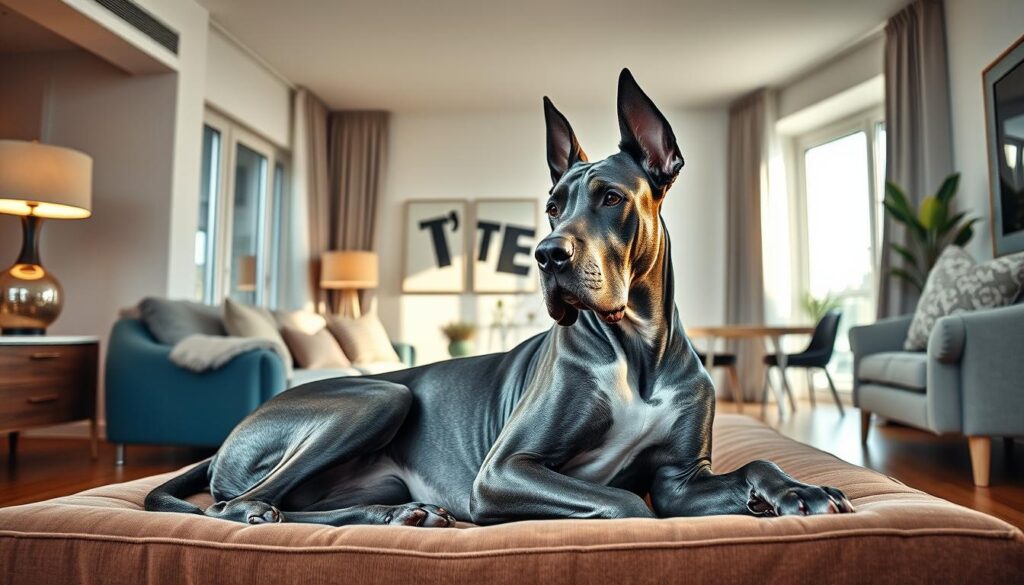
With their quiet and laid-back temperament, Great Danes can thrive in apartment living, provided there’s enough space to accommodate their large size. Despite weighing between 100 to 130 pounds, their calm and quiet nature makes them an ideal choice for apartment dwellers without weight restrictions.
Great Danes are known for their gentle giant reputation, and their unparalleled trainability adds to their appeal as apartment dogs. They are better suited for apartment living than many smaller, more active breeds due to their peaceful temperament.
Calm, Quiet Nature Despite Intimidating Size
Great Danes have a calm demeanor that makes them perfect for apartment living. Their quiet nature ensures they won’t disturb neighbors, and their gentle disposition makes them a great companion.
Surprisingly Low Energy Levels Perfect for Indoor Living
Despite their large size, Great Danes have surprisingly low energy levels, making them suitable for indoor living. They don’t require a lot of exercise, but they do need regular walks to stay healthy.
Simple Grooming Needs but Space Considerations
Great Danes have a short, smooth coat that requires minimal grooming, making them relatively low-maintenance despite their size. However, they do need enough space to move around comfortably in your apartment.
To accommodate a Great Dane’s needs, consider investing in appropriately sized beds, crates, and feeding stations. Efficient cleaning strategies will also help manage their moderate shedding patterns.
10. Mastiff: The Docile, Low-Energy Large Breed

The Mastiff, despite its massive size, is a surprisingly adaptable breed for apartment living due to its calm nature. This breed is known for being calm, dignified, docile, and affectionate, making them excellent family pets, especially for those with children.
Mastiffs are generally quiet and rarely bark, which is a significant advantage in an apartment setting where noise can be a concern for neighbors. Their temperament is not just calm but also loyal and loving, making them great companions.
Dignified, Affectionate Temperament with Minimal Barking
Mastiffs have a dignified and affectionate temperament that makes them ideal for families. They are known to be excellent with children and are generally quiet, minimizing the risk of noise complaints in an apartment.
Modest Exercise Requirements Despite Massive Size
Despite their large size, Mastiffs have modest exercise needs. They require regular, short walks and playtime, which can be easily managed within an apartment’s confines. This makes them a practical choice for apartment living.
Easy Grooming Routine and Space Management Tips
The Mastiff’s short, smooth coat requires minimal grooming, making them a relatively low-maintenance breed. To manage their size in an apartment, it’s essential to have a thoughtful furniture arrangement and designated dog areas. Regular brushing and efficient cleaning strategies can help manage shedding.
Common Challenges of Apartment Dog Ownership
While having a dog in an apartment can be incredibly rewarding, there are several common challenges that owners should be aware of. These challenges can range from dealing with separation anxiety to managing bathroom breaks without a yard. Understanding these issues is crucial for providing a happy and healthy environment for your dog.
Preventing Separation Anxiety in Limited Spaces
Separation anxiety is a common issue in dogs living in apartments due to the close quarters and potential for increased interaction with owners. To prevent this, owners can gradually increase alone time, starting from small intervals, and provide engaging toys or puzzle toys filled with treats to keep the dog occupied.
Managing Bathroom Breaks Without a Yard
Managing bathroom breaks is a significant challenge for apartment dog owners. Regular walks and establishing a routine can help. Additionally, considering dog litter or indoor potty solutions can be beneficial for times when outdoor access is limited.
Keeping Your Dog Mentally Stimulated Indoors
Mental stimulation is crucial for apartment dogs who may have limited opportunities for physical exercise and environmental variety. Engaging your dog with puzzle toys, indoor games, and training exercises can help keep their mind active. Rotating toys and creating novel experiences within the apartment can prevent habituation and maintain interest.
| Activity | Description | Benefits |
|---|---|---|
| Puzzle Toys | Toys filled with treats that challenge the dog to figure out how to get them out. | Mental Stimulation, Reduces Boredom |
| Indoor Games | Games like hide-and-seek or indoor fetch. | Physical Exercise, Mental Stimulation |
| Training Exercises | Teaching new tricks or commands. | Mental Stimulation, Strengthens Bond |
Creating a Dog-Friendly Apartment Environment
Transforming your apartment into a dog-friendly haven requires some creativity and planning. To make your living space comfortable and enjoyable for both you and your dog, consider a few key factors.
Space-Efficient Dog Supplies and Storage Solutions
Apartment living means limited space, so it’s essential to optimize storage for your dog’s supplies. Using multi-functional furniture and hidden storage can help keep your dog’s essentials organized without cluttering your living area. For example, storage ottomans or under-bed storage bins can be great for stashing dog toys, leashes, and grooming tools.
Some popular storage solutions include:
- Collapsible dog crates
- Wall-mounted shelves for dog supplies
- Hidden compartments in furniture
Soundproofing Tips for Barking Management
Barking can be a significant concern in apartment living, both for you and your neighbors. To minimize disturbance, consider soundproofing your apartment. Simple steps like adding area rugs, installing acoustic panels, or sealing gaps around doors can significantly reduce noise levels.
Additionally, training your dog to bark less is crucial. Techniques such as positive reinforcement training can be very effective.
Apartment-Friendly Exercise Equipment and Toys
Regular exercise is vital for your dog’s health, even in an apartment setting. Investing in apartment-friendly exercise equipment like treadmills or indoor agility equipment can provide your dog with the physical activity they need. Interactive toys and puzzle feeders are also excellent for mental stimulation.
| Equipment | Description | Benefits |
|---|---|---|
| Treadmill | A motorized belt for walking or running | Provides cardiovascular exercise |
| Indoor Agility Equipment | Tunnels, cones, and jumps for training | Improves agility and obedience |
| Puzzle Feeders | Toys that challenge dogs to get treats | Mentally stimulates your dog |
Adoption Considerations for Apartment Dogs
Apartment dwellers can find their perfect canine companion by asking the right questions at shelters. Adopting a dog is a significant decision that requires careful consideration of both your lifestyle and the dog’s needs.
Benefits of Adopting Adult Dogs with Known Temperaments
Adult dogs in shelters often have known temperaments, making it easier to assess their suitability for apartment living. Shelter staff and foster families can provide valuable insights into a dog’s behavior, noise level, and energy requirements. This information is crucial in determining whether a dog will thrive in an apartment environment.
For instance, some adult dogs may have already received basic training, reducing the likelihood of destructive behavior when left alone. Moreover, their personalities are more established, allowing for a more accurate match with your lifestyle.
Questions to Ask Shelters About Apartment Compatibility
To ensure a successful adoption, it’s essential to ask the right questions. Here are some key inquiries to make at the shelter:
| Question | Relevance to Apartment Living |
|---|---|
| How does the dog react to noise? | Assesses the dog’s sensitivity to apartment noises. |
| Has the dog shown separation anxiety? | Indicates potential issues when left alone. |
| What is the dog’s energy level? | Helps determine exercise needs. |
By asking these questions and understanding the dog’s behavior, you can make an informed decision about adopting a dog that’s compatible with your apartment lifestyle.

Conclusion: Finding Your Perfect Apartment Companion
The journey to finding your ideal apartment dog involves understanding the unique challenges and opportunities of small-space living. To create a harmonious match, it’s crucial to balance breed characteristics with your specific living situation and lifestyle.
Throughout this guide, we’ve explored key considerations for apartment dog ownership, including size, noise level, energy requirements, and grooming needs. We’ve also highlighted the top 10 breeds suitable for apartment living, from the quiet French Bulldog to the gentle Great Dane.
When selecting a companion dog, remember that individual temperament can be more important than breed generalizations. Take your time, and consider fostering or extended meet-and-greets before making a commitment. Successful apartment dog ownership requires ongoing adaptation and commitment.
With the right preparation and breed selection, apartment living can provide a wonderful environment for both you and your dog. By understanding the needs of different dogs and being mindful of your lifestyle, you can create a happy and healthy home for your new companion.

